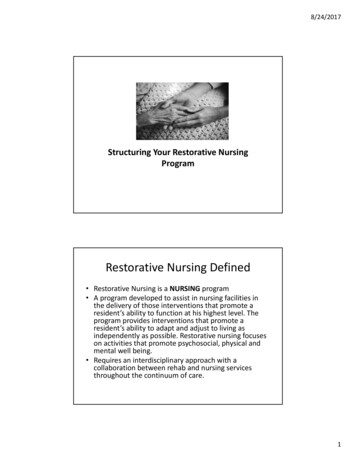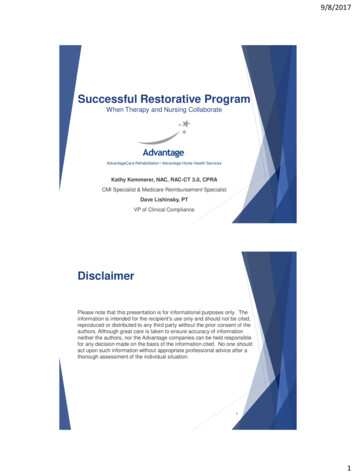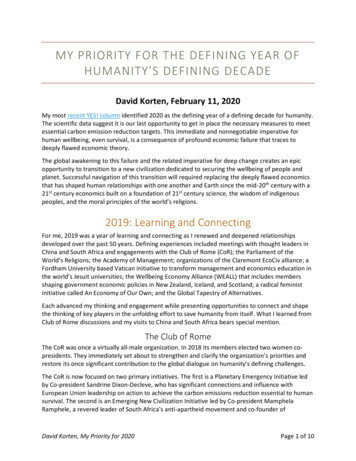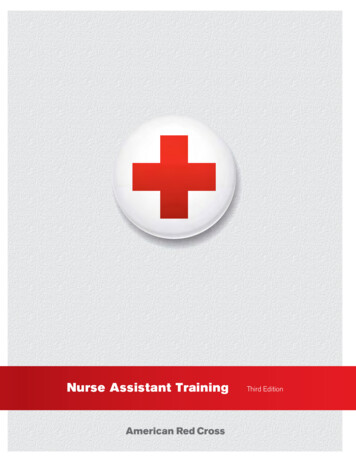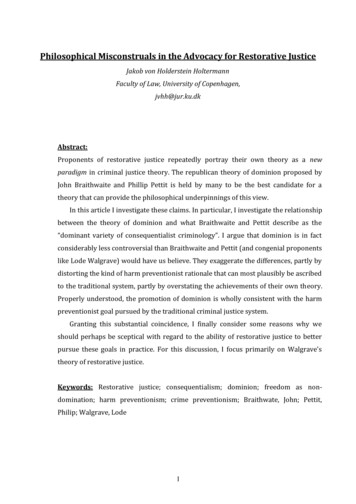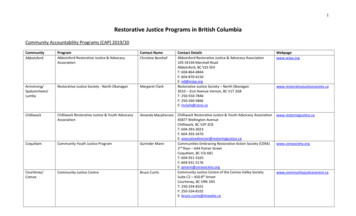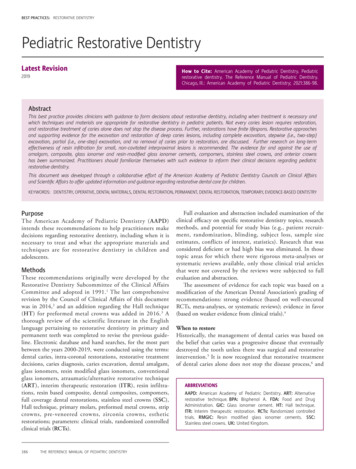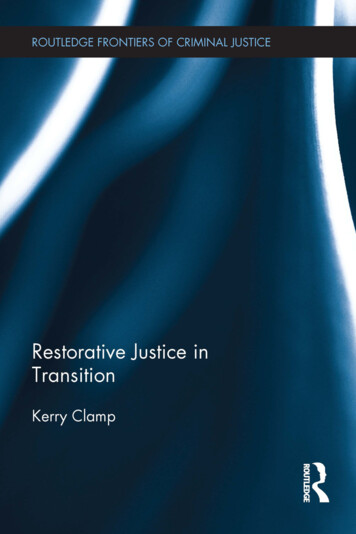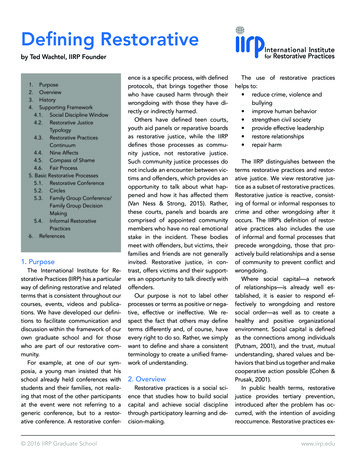
Transcription
Defining Restorativeby Ted Wachtel, IIRP Founder1.2.3.4.PurposeOverviewHistorySupporting Framework4.1. Social Discipline Window4.2. Restorative JusticeTypology4.3. Restorative PracticesContinuum4.4. Nine Affects4.5. Compass of Shame4.6. Fair Process5. Basic Restorative Processes5.1. Restorative Conference5.2. Circles5.3. Family Group Conference/Family Group DecisionMaking5.4. Informal RestorativePractices6. References1. PurposeThe International Institute for Restorative Practices (IIRP) has a particularway of defining restorative and relatedterms that is consistent throughout ourcourses, events, videos and publications. We have developed our definitions to facilitate communication anddiscussion within the framework of ourown graduate school and for thosewho are part of our restorative community.For example, at one of our symposia, a young man insisted that hisschool already held conferences withstudents and their families, not realizing that most of the other participantsat the event were not referring to ageneric conference, but to a restorative conference. A restorative confer- 2016 IIRP Graduate Schoolence is a specific process, with definedprotocols, that brings together thosewho have caused harm through theirwrongdoing with those they have directly or indirectly harmed.Others have defined teen courts,youth aid panels or reparative boardsas restorative justice, while the IIRPdefines those processes as community justice, not restorative justice.Such community justice processes donot include an encounter between victims and offenders, which provides anopportunity to talk about what happened and how it has affected them(Van Ness & Strong, 2015). Rather,these courts, panels and boards arecomprised of appointed communitymembers who have no real emotionalstake in the incident. These bodiesmeet with offenders, but victims, theirfamilies and friends are not generallyinvited. Restorative justice, in contrast, offers victims and their supporters an opportunity to talk directly withoffenders.Our purpose is not to label otherprocesses or terms as positive or negative, effective or ineffective. We respect the fact that others may defineterms differently and, of course, haveevery right to do so. Rather, we simplywant to define and share a consistentterminology to create a unified framework of understanding.2. OverviewRestorative practices is a social science that studies how to build socialcapital and achieve social disciplinethrough participatory learning and decision-making.The use of restorative practiceshelps to: reduce crime, violence andbullying improve human behavior strengthen civil society provide effective leadership restore relationships repair harmThe IIRP distinguishes between theterms restorative practices and restorative justice. We view restorative justice as a subset of restorative practices.Restorative justice is reactive, consisting of formal or informal responses tocrime and other wrongdoing after itoccurs. The IIRP’s definition of restorative practices also includes the useof informal and formal processes thatprecede wrongdoing, those that proactively build relationships and a senseof community to prevent conflict andwrongdoing.Where social capital—a networkof relationships—is already well established, it is easier to respond effectively to wrongdoing and restoresocial order—as well as to create ahealthy and positive organizationalenvironment. Social capital is definedas the connections among individuals(Putnam, 2001), and the trust, mutualunderstanding, shared values and behaviors that bind us together and makecooperative action possible (Cohen &Prusak, 2001).In public health terms, restorativejustice provides tertiary prevention,introduced after the problem has occurred, with the intention of avoidingreoccurrence. Restorative practices ex-www.iirp.edu
Defining Restorativepands that effort with primary prevention, introduced before the problemhas occurred.The social science of restorativepractices offers a common thread totie together theory, research and practice in diverse fields such as education,counseling, criminal justice, social workand organizational management. Individuals and organizations in many fieldsare developing models and methodology and performing empirical researchthat share the same implicit premise,but are often unaware of the commonality of each other’s efforts.For example, in criminal justice, restorative circles and restorative conferences allow victims, offenders andtheir respective family members andfriends to come together to explorehow everyone has been affected by anoffense and, when possible, to decidehow to repair the harm and meet theirown needs (McCold, 2003). In socialwork, family group decision-making(FGDM) or family group conferencing(FGC) processes empower extendedfamilies to meet privately, without professionals in the room, to make a planto protect children in their own families from further violence and neglector to avoid residential placement outside their own homes (American Humane Association, 2003). In education,circles and groups provide opportunities for students to share their feelings,build relationships and solve problems,and when there is wrongdoing, to playan active role in addressing the wrongand making things right (Riestenberg,2002).These various fields employ differentterms, all of which fall under the rubricof restorative practices: In the criminaljustice field, the phrase used is “restorative justice” (Zehr, 1990); in social 2016 IIRP Graduate School2work, the term employed is “empowerment” (Simon, 1994); in education,talk is of “positive discipline” (Nelsen,1996) or “the responsive classroom”(Charney, 1992); and in organizationalleadership, “horizontal management”(Denton, 1998) is referenced. The social science of restorative practices recognizes all of these perspectives andincorporates them into its scope.3. HistoryRestorative practices has its roots inrestorative justice, a way of looking atcriminal justice that emphasizes repairing the harm done to people and relationships rather than only punishingoffenders (Zehr, 1990).In the modern context, restorativejustice originated in the 1970s as mediation or reconciliation between victimsand offenders. In 1974 Mark Yantzi,a probation officer, arranged for twoteenagers to meet directly with theirvictims following a vandalism spreeand agree to restitution. The positiveresponse by the victims led to the firstvictim-offender reconciliation program,in Kitchener, Ontario, Canada, withthe support of the Mennonite CentralCommittee and collaboration with thelocal probation department (McCold,1999; Peachey, 1989). The conceptsubsequently acquired various names,such as victim-offender mediation andvictim-offender dialogue, as it spreadthrough North America and to Europethrough the 1980s and 1990s (Umbreit& Greenwood, 2000).Restorative justice echoes ancientand indigenous practices employed incultures all over the world, from NativeAmerican and First Nation Canadianto African, Asian, Celtic, Hebrew, Araband many others (Eagle, 2001; Goldstein, 2006; Haarala, 2004; Mbambo &Skelton, 2003; Mirsky, 2004; Roujanavong, 2005; Wong, 2005).Eventually modern restorative justice broadened to include communities of care as well, with victims’ andoffenders’ families and friends participating in collaborative processes calledconferences and circles. Conferencingaddresses power imbalances betweenthe victim and offender by includingadditional supporters (McCold, 1999).The family group conference (FGC)started in New Zealand in 1989 as aresponse to native Maori people’s concerns with the number of their childrenbeing removed from their homes bythe courts. It was originally envisionedas a family empowerment process, notas restorative justice (Doolan, 2003). InNorth America it was renamed familygroup decision making (FGDM) (Burford & Pennell, 2000).In 1991 the FGC was adapted byan Australian police officer, TerryO’Connell, as a community policingstrategy to divert young people fromcourt. The IIRP now calls that adaptation, which has spread around theworld, a restorative conference. It hasbeen called other names, such as acommunity accountability conference(Braithwaite, 1994) and victim-offenderconference (Amstutz & Zehr, 1998).In 1994, Marg Thorsborne, an Australian educator, was the first to usea restorative conference in a school(O’Connell, 1998).The International Institute for Restorative Practices (IIRP) grew out of theCommunity Service Foundation andBuxmont Academy, which since 1977have provided programs for delinquentand at-risk youth in southeastern Pennsylvania, USA. Initially founded in 1994under the auspices of Buxmont Academy, the Real Justice program, now anwww.iirp.edu
Defining RestorativeIIRP program, has trained professionalsaround the world in restorative conferencing. In 1999 the newly created IIRPbroadened its training to informal andproactive restorative practices, in addition to formal restorative conferencing(Wachtel, 1999). Since then the IIRP, anaccredited graduate school, has developed a comprehensive frameworkfor practice and theory that expandsthe restorative paradigm far beyondits origins in criminal justice (McCold& Wachtel, 2001, 2003). Use of restorative practices is now spreading worldwide, in education, criminal justice, social work, counseling, youth services,workplace and faith community applications (Wachtel, 2013).4. Supporting FrameworkThe IIRP has identified several concepts that it views as most helpful inexplaining and understanding restorative practices.4.1. Social Discipline WindowThe social discipline window (Figure1) is a concept with broad applicationin many settings. It describes four basic approaches to maintaining socialnorms and behavioral boundaries. Thefour are represented as different combinations of high or low control andhigh or low support. The restorativedomain combines both high controland high support and is characterizedby doing things with people, ratherthan to them or for them.The social discipline window alsodefines restorative practices as a leadership model for parents in families,teachers in classrooms, administratorsand managers in organizations, policeand social workers in communities andjudges and officials in government.The fundamental unifying hypothesis 2016 IIRP Graduate rnalisticFigure 1. Social Discipline Windowof restorative practices is that “humanbeings are happier, more cooperativeand productive, and more likely tomake positive changes in their behavior when those in positions of authority do things with them, rather thanto them or for them.” This hypothesismaintains that the punitive and authoritarian to mode and the permissive andpaternalistic for mode are not as effective as the restorative, participatory,engaging with mode (Wachtel, 2005).The social discipline window, whosedynamics of low versus high supportand control were originally modelledby the work of University of Illinoiscorrections researcher Daniel Glaser,reflects the seminal thinking of renowned Australian criminologist JohnBraithwaite, who has asserted that reliance on punishment as a social regulator is problematic because it shamesand stigmatizes wrongdoers, pushesthem into a negative societal subculture and fails to change their behavior (Glaser, 1964; Braithwaite, 1989).The restorative approach, on the otherhand, reintegrates wrongdoers backinto their community and reduces thelikelihood that they will reoffend.4.2. Restorative Justice TypologyRestorative justice is a process involving the primary stakeholders in determining how best to repair the harmdone by an offense. The three primarystakeholders in restorative justice arevictims, offenders and their communitiesof care, whose needs are, respectively,!obtaining reparation, taking responsibility and achieving reconciliation. Thedegree to which all three are involvedin meaningful emotional exchange anddecision making is the degree to whichany form of social discipline approachesbeing fully restorative.The three primary stakeholders arerepresented in Figure 2 by the threeoverlapping circles. The very processof interacting is critical to meetingstakeholders’ emotional needs. Theemotional exchange necessary formeeting the needs of all those directlyaffected cannot occur with only onewww.iirp.edu
Defining Restorative4Types and Degrees of Restorative Justice Practicevictimreparationcommunities of carereconciliationvictim supportcirclesvictimservicesoffender ictimrestitutionpeacecirclesfamily groupvictimlessconferencing iationfamily-centeredsocial dcommunity serviceyouth aidpanelsreparativeboardsvictim esponsibilityfully restorativemostly restorativepartly restorativeFigure 2. Restorative Justice Typologyset of stakeholders participating. Themost restorative processes involve theactive participation of all three sets ofprimary stakeholders (McCold & Wachtel, 2003).When criminal justice practices involve only one group of primary stakeholders, as in the case of governmental financial compensation for victimsor meaningful community service workassigned to offenders, the processcan only be called partly restorative.When a process such as victim-offender mediation includes two principalstakeholders but excludes their communities of care, the process is mostlyrestorative. Only when all three sets ofprimary stakeholders are actively involved, such as in conferences or circles, is a process fully restorative (McCold & Wachtel, 2003). 2016 IIRP Graduate School4.3. Restorative Practices ContinuumRestorative practices are not limited to formal processes, such as restorative conferences or family groupconferences, but range from informalto formal. On a restorative practicescontinuum (Figure 3), the informalpractices include affective statementsthat communicate people’s feelings, aswell as affective questions that causepeople to reflect on how their behaviorhas affected others. Impromptu restor-ative conferences, groups and circlesare somewhat more structured but donot require the elaborate preparationneeded for formal conferences. Moving from left to right on the continuum,as restorative practices become moreformal, they involve more people, require more planning and time, andare more structured and complete.Although a formal restorative processmight have dramatic impact, informalpractices have a cumulative impactbecause they are part of everyday life(McCold & Wachtel, 2001).The aim of restorative practices isto develop community and to manage conflict and tensions by repairingharm and building relationships. Thisstatement identifies both proactive(building relationships and developing community) and reactive (repairing harm and restoring relationships)approaches. Organizations and services that only use the reactive without building the social capital beforehand are less successful than thosethat also employ the proactive (Davey, 2007).4.4. Nine AffectsThe most critical function of restorative practices is restoring and buildingrelationships. Because informal andformal restorative processes foster theexpression of affect or emotion, theyalso foster emotional bonds. The lateSilvan S. Tomkins’s writings about psychology of affect (Tomkins, 1962, 1963,Figure 3. Restorative Practices Continuumwww.iirp.edu
Defining Restorative5The Nine Affects 2016 IIRP Graduate SchoolckAtta Selfack OtherAttNegativeAffectsNeu tralPositiveAffe ctsshame-humiliation. Surprise-startle is worse (Nathanson, 1997b).the neutral affect, which functions likeBy encouraging people to expressEnjoyment — Joya reset button. The two positive affects their feelings, restorative practicesInterest — Excitementare interest-excitement and enjoy- build better relationships. Restorativement-joy (Tomkins, 1962, 1963, 1991). practices demonstrate the fundamentalSurprise — StartleSilvan S. Tomkins (1962) wrote that hypothesis of Tomkins’s psychology ofbecause we have evolved to experi- affect—that the healthiest environmentShame — Humiliationence nine affects—two positive affects for human beings is one in which thereDistress — Anguishthat feel pleasant, one (surprise-star- is free expression of affect, minimiztle) so brief that it has no feeling of its ing the negative and maximizing theDisgustown, and six that feel dreadful—we are positive (Nathanson, 1992). From theFear — Terrorhardwired to conform to an internal simple affective statement to the forblueprint. The human emotional blue- mal conference, that is what restorativeAnger — Rageprint ensures that we feel best when we practices are designed to do (Wachtel,1) maximize positive affect and 2) min- 1999).Dissmellimize negative affect; we function bestFigure 4. The Nine Affects4.5. Compass of ShameAdapted from Nathanson, 1992 when 3) we express all affect (minimize(adapted from Nathanson, 1992)the inhibition of affect) so we can acShame is worthy of special attencomplish these two goals; and, finally, tion. Nathanson explains that shame is1991) assert that human relationships 4) anything that fosters these three a critical regulator of human social beare best and healthiest when there is goals makes us feel our best, whereas havior. Tomkins defines shame as ocfree expression of affect or emotion— any force that interferes with any one curring any time that our experience ofThe Compass of Shameminimizing the negative, maximiz- or more of those goals makes us feel the positive affects is interrupted (Toming the positive, but allowing for freeWithdrawal:expression. Donald Nathanson, for isolating oneselfmer director of the Silvan S. Tomkins running and hidingInstitute, added that it is through themutual exchange of expressed affectdrawalthat we build community, creating theWithemotional bonds that tie us all together (Nathanson, 1998). Restorative practices such as conferences and circlesAttack Other:Attack Self: "turning the tables"provide a safe environment for people self put-down blaming the victimto express and exchange emotion (Na masochism lashing out verballyor physicallythanson, 1998).Tomkins identified nine distinct affects (Figure 4) to explain the expression of emotion in all humans. MostAvoid a n c eof the affects are defined by pairs ofwords that represent the least and theAvoidance:most intense expression of a particu deniallar affect. The six negative affects in abusing drugs and alcohol distraction through thrill-seekingclude anger-rage, fear-terror, distressanguish, disgust, dissmell (a wordFigure 5. The Compass of ShameTomkins coined to describe thanson, 1992up one’s nose” in a rejecting way) andwww.iirp.edu
Defining Restorativekins, 1987). So an individual does nothave to do something wrong to feelshame. The individual just has to experience something that interrupts interest-excitement or enjoyment-joy (Nathanson, 1997a). This understanding ofshame provides a critical explanationfor why victims of crime often feel astrong sense of shame, even though itwas the offender who committed the“shameful” act (Angel, 2005).Nathanson (1992) has developed theCompass of Shame (Figure 5) to illustrate the various ways that human beings react when they feel shame. Thefour poles of the compass of shame andbehaviors associated with them are: Withdrawal—isolating oneself,running and hiding Attack self—self put-down,masochism Avoidance—denial, abusingdrugs, distraction through thrillseeking Attack others—turning thetables, lashing out verbally orphysically, blaming othersNathanson says that the attack otherresponse to shame is responsible forthe proliferation of violence in modernlife. Usually people who have adequateself-esteem readily move beyond theirfeelings of shame. Nonetheless we allreact to shame, in varying degrees, inthe ways described by the Compass.Restorative practices, by their very nature, provide an opportunity for us toexpress our shame, along with otheremotions, and in doing so reduce theirintensity. In restorative conferences, forexample, people routinely move fromnegative affects through the neutralaffect to positive affects (Nathanson,1998). 2016 IIRP Graduate School64.6. Fair ProcessWhen authorities do things withpeople, whether reactively—to dealwith crisis—or proactively, the resultsare better. This fundamental thesis wasevident in a Harvard Business Reviewarticle about the concept of fair process producing effective outcomes inbusiness organizations (Kim & Mauborgne, 2003). The central idea of fairprocess is that “ individuals are mostlikely to trust and cooperate freely withsystems—whether they themselves winor lose by those systems—when fairprocess is observed” (Kim & Mauborgne, 2003).The three principles of fair processare: Engagement—involving individuals in decisions that affectthem by listening to their viewsand genuinely taking their opinions into account Explanation—explaining thereasoning behind a decision toeveryone who has been involved or who is affected by it Expectation clarity—makingsure that everyone clearly understands a decision and whatis expected of them in the future (Kim & Mauborgne, 2003)Fair process demonstrates the restorative with domain of the social discipline window. It relates to how leaders handle their authority in all kindsof professions and roles: from parentsand teachers to managers and administrators. The fundamental hypothesisof restorative practices embodies fairprocess by asserting that “people arehappier, more cooperative and productive, and more likely to make positive changes in behavior when those inauthority do things with them, ratherthan to them or for them.”5. Restorative ProcessesThe IIRP has identified several restorative processes that it views asmost helpful in implementing restorative practices in the widest variety ofsettings.5.1. Restorative ConferenceA restorative conference is a structured meeting between offenders,victims and both parties’ family andfriends, in which they deal with theconsequences of the crime or wrongdoing and decide how best to repairthe harm. Neither a counseling nor amediation process, conferencing is avictim-sensitive, straightforward problem-solving method that demonstrateshow citizens can resolve their ownproblems when provided with a constructive forum to do so (O’Connell,Wachtel, & Wachtel, 1999).Conferences provide victims andothers with an opportunity to confrontthe offender, express their feelings, askquestions and have a say in the outcome. Offenders hear firsthand howtheir behavior has affected people. Offenders may choose to participate ina conference and begin to repair theharm they have caused by apologizing, making amends and agreeing tofinancial restitution or personal or community service work. Conferences holdoffenders accountable while providingthem with an opportunity to discardthe “offender” label and be reintegrated into their community, school orworkplace (Morris & Maxwell, 2001).Participation in conferences is voluntary. After it is determined that aconference is appropriate and offenders and victims have agreed to attend,the conference facilitator invites otherswww.iirp.edu
Defining Restorativeaffected by the incident—the familyand friends of victims and offenders(O’Connell, Wachtel, & Wachtel, 1999).A restorative conference can beused in lieu of traditional disciplinaryor justice processes, or where that isnot appropriate, as a supplement tothose processes (O’Connell, Wachtel,& Wachtel, 1999).In the Real Justice approach to restorative conferences, developed by Australian police officer Terry O’Connell,the conference facilitator sticks to asimple written script. The facilitatorkeeps the conference focused but isnot an active participant. In the conference the facilitator provides an opportunity to each participant to speak,beginning with asking open-ended andaffective restorative questions of the offender. The facilitator then asks victimsand their family members and friendsquestions that provide an opportunityto tell about the incident from their perspective and how it affected them. Theoffenders’ family and friends are askedto do the same (O’Connell, Wachtel, &Wachtel, 1999).Using the conference script, offenders are asked these restorative questions: “What happened?” “What were you thinking of atthe time?” “What have you thought aboutsince?” “Who has been affected bywhat you have done?” “What do you think you needto do to make things right?”Victims are asked these restorativequestions: “What did you think when yourealized what happened?” “What impact has this incident 2016 IIRP Graduate School7 had on you and others?”“What has been the hardestthing for you?”“What do you think needs tohappen to make things right?”Finally, the victim is asked what heor she would like to be the outcomeof the conference. The response is discussed with the offender and everyoneelse at the conference. When agreement is reached, a simple contract iswritten and signed (O’Connell, Wachtel, & Wachtel, 1999).Restorative conferencing is an approach to addressing wrongdoing invarious settings in a variety of ways(O’Connell, Wachtel, & Wachtel, 1999): Conferencing can be employedby schools in response to truancy, disciplinary incidents, including violence, or as a preventionstrategy in the form of role-playsof conferences with primary andsecondary school students. Police can use conferences as awarning or diversion from court,especially with first-time offenders. Courts may use conferencing asa diversion, an alternative sentencing process, or a healingevent for victims and offenders after the court process isconcluded. Juvenile and adult probationofficers may respond to various probation violations withconferences. Correctional and treatment facilities will find that conferencesresolve the underlying issuesand tensions in conflicts anddisciplinary actions. Colleges and universities canuse conferences with residence hall and campus incidents anddisciplinary violations.In workplaces, conferencesaddress both wrongdoing andconflict.Some approaches to restorative conferences, such as in Ulster in NorthernIreland, do not use the Real Justicescript approach (Chapman, 2006). Victim-offender conferences do not relyon a script, either. Based on the earlierrestorative justice model of victim-offender mediation, but widening the circle of participants, the victim-offenderapproach to conferences still relies onmediators who more actively managethe process (Amstutz & Zehr, 1998).The IIRP prefers the Real Justicescripted model of conferencing because we believe it has the greatest potential to meet the needs of the stakeholders described in the RestorativeJustice Typology. In addition, researchshows that it consistently provides veryhigh levels of satisfaction and sense offairness for all participants (McCold &Wachtel, 2002). However, we do notmean to quibble with other approaches. As long as people experience asafe opportunity to have a meaningfuldiscussion that helps them address theemotional and other consequences ofa conflict or a wrong, the process isbeneficial.5.2. CirclesA circle is a versatile restorativepractice that can be used proactively,to develop relationships and buildcommunity or reactively, to respond towrongdoing, conflicts and problems.Circles give people an opportunity tospeak and listen to one another in anatmosphere of safety, decorum andequality. The circle process allows peo-www.iirp.edu
Defining Restorativeple to tell their stories and offer theirown perspectives (Pranis, 2005).The circle has a wide variety of purposes: conflict resolution, healing, support, decision making, information exchange and relationship development.Circles offer an alternative to contemporary meeting processes that oftenrely on hierarchy, win-lose positioningand argument (Roca, Inc., n.d.).Circles can be used in any organizational, institutional or community setting. Circle time (Mosley, 1993) andmorning meetings (Charney, 1992)have been widely used in primary andelementary schools for many years andmore recently in secondary schoolsand higher education (Mirsky, 2007,2011; Wachtel & Wachtel, 2012). In industry, the quality circle has been employed for decades to engage workersin achieving high manufacturing standards (Nonaka, 1993). In 1992, YukonCircuit Court Judge Barry Stewart pioneered the sentencing circle, which involved community members in helpingto decide how to deal with an offender(Lilles, 2002). In 1994, Mennonite Pastor Harry Nigh befriended a mentallychallenged repeat sex offender byforming a support group with someof his parishioners, called a circle ofsupport and accountability, which waseffective in preventing re-offending(Rankin, 2007).Circles may use a sequential format.One person speaks at a time, and theopportunity to speak moves in one direction around the circle. Each personmust wait to speak until his or her turn,and no one may interrupt. Optionally,a talking piece—a small object that iseasily held and passed from person toperson—may be used to facilitate thisprocess. Only the person who is holding the talking piece has the right to 2016 IIRP Graduate School8speak (Costello, Wachtel, & Wachtel,2010). Both the circle and the talkingpiece have roots in ancient and indigenous practices (Mirsky, 2004a, 2004b;Roca, Inc., n.d.)The sequential circle is typicallystructured around topics or questionsraised by the circle facilitator. Becauseit strictly forbids back-and-forth argument, it provides a great deal of decorum. The format maximizes the opportunity for the quiet voices, thosethat are usually inhibited by louder andmore assertive people, to speak without interruption. Individuals who wantto respond to something that has beensaid must be patient and wait until itis thei
way of defining restorative and related terms that is consistent throughout our courses, events, videos and publica-tions. We have developed our defini-tions to facilitate communication and discussion within the framework of our own graduate school and for those who are part of our restorative com-munity. For example, at one of our sym-

